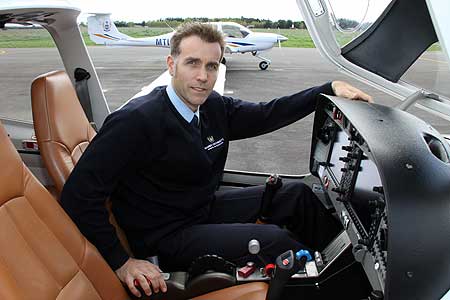Massey's leading approach in aviation safety project

The School of Aviation's approach to safety training for pilots has impressed members of the Australian aviation industry.
Deputy chief flight instructor Paul Kearney was invited by the Australian Civil Aviation Safety Authority to give a guest speech National Chief Flying Instructors Conference in Canberra last month.
Mr Kearney says the school took the initiative to develop what is known as threat and error management (TEM) into its training programme when the new fleet of Diamond aircraft was purchased two years ago.
He says the principles of TEM were embedded in a number of existing procedures in the school and, working alongside the Air New Zealand Aviation Institute, the process was formalised. This predated the legislative requirement for TEM that took effect last year in New Zealand.
“While most commercial aircraft have a two-pilot operation, we had to develop this process and apply it to a single pilot model,” Mr Kearney says.
Standard operating procedures for all flight operations were published by the school, which introduced scenario-based training for every flight lesson and developed a model for “before start” and “top of descent” checklists.
A crew concept was also developed as a result of research by the school's chief flight examiner, Dr Ritchie de Montalk, who identified the need for "soft" skills such as teamwork, leadership and customer awareness to be taught during flight training because of their importance to the role of modern airline pilots.
Students fly in pairs like an airline crew and share the jobs such as checking weather, planning the flight, ordering fuel and doing a pre checks on the aircraft. It is used on all training flights.
“Traditionally, when you teach someone to fly you will go through each procedure in turn so if you are showing them how to land you will show them and they will do it,” Mr Kearney says. “We take a scenario-based approach from day one. For example, an exercise might be that you are taking friends to a rugby match in New Plymouth, which will test your time management and fuel skills. When you are there you are told the weather closes in so you have to land back in Palmerston North using your instruments. This is the type of threat and error management we are including.”
Mr Kearney, who is also the school's quality assurance manager, says scenario-based training is little used in the Asia-Pacific and the delegates at the conference, including aeroplane and helicopter chief flying instructors, chief pilots and chief ground instructors, were very interested in Massey’s approach.
“The project has been an exciting challenge with encouraging results. I had several people come up to me after my presentation to comment about how much they enjoyed it, but more importantly to ask more questions about the great work we are doing with scenario-based training and threat and error management at Massey.”